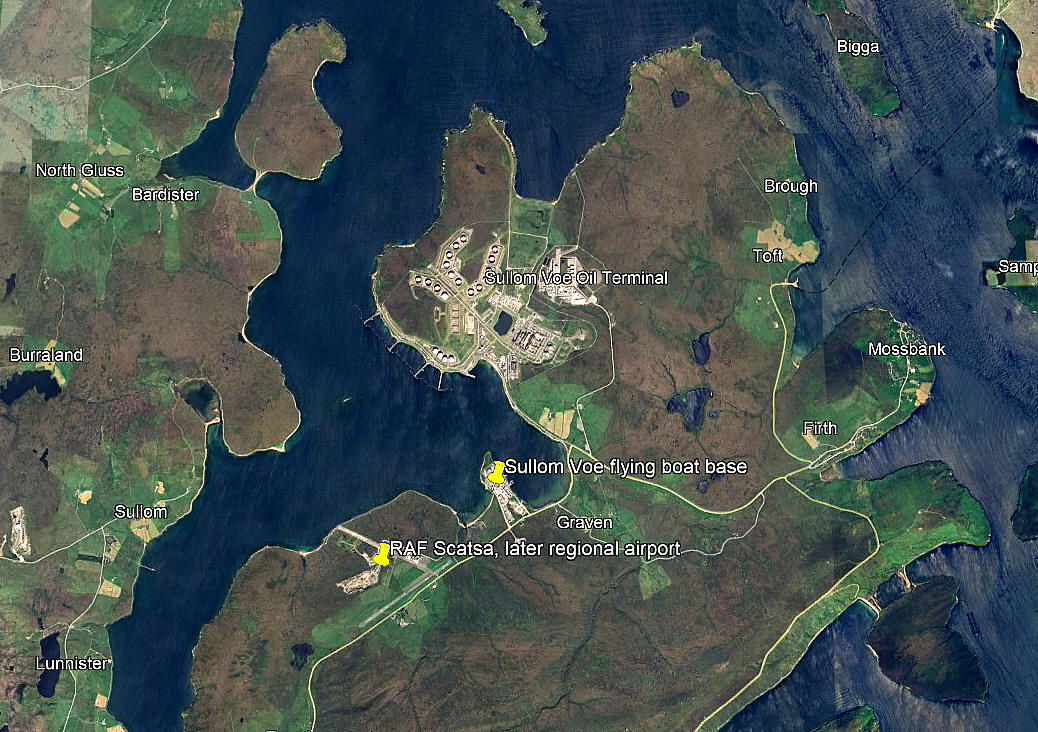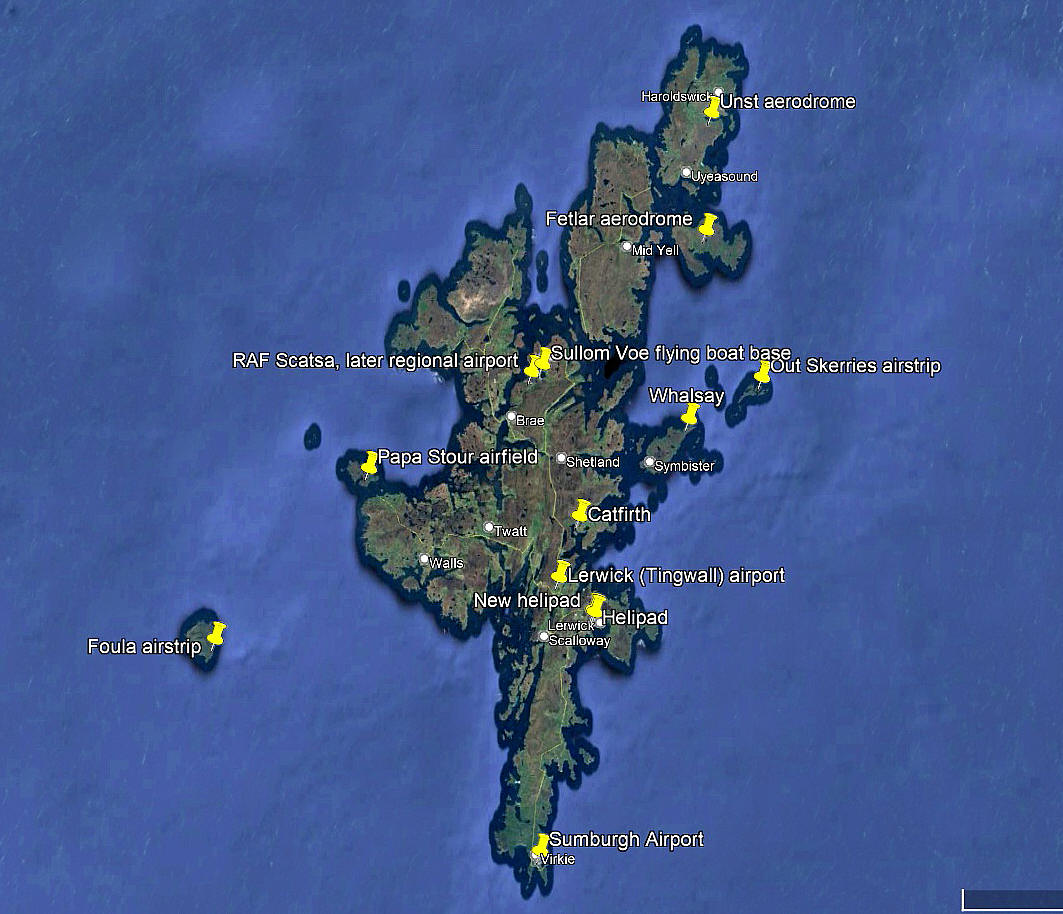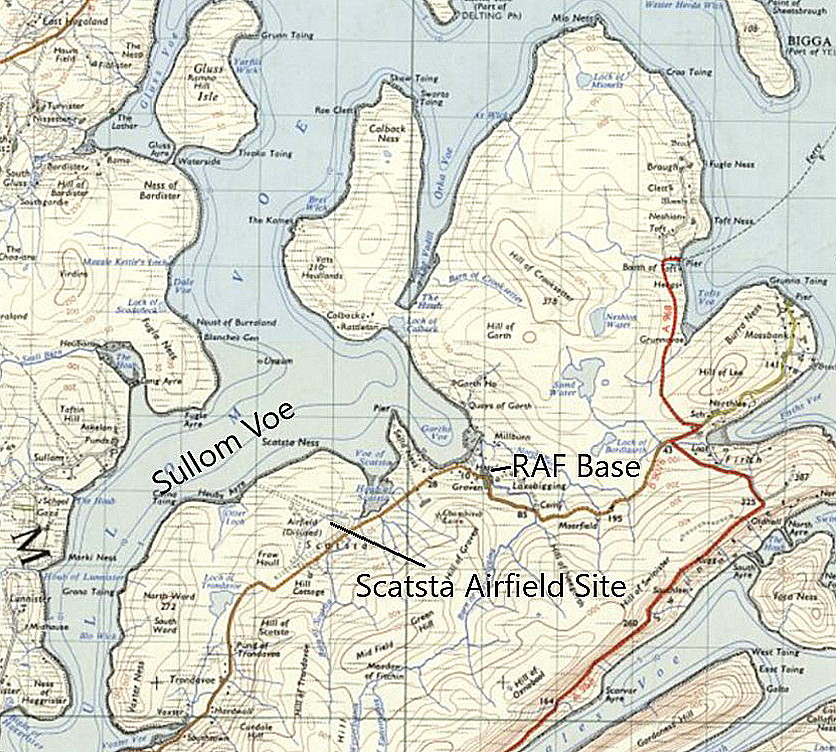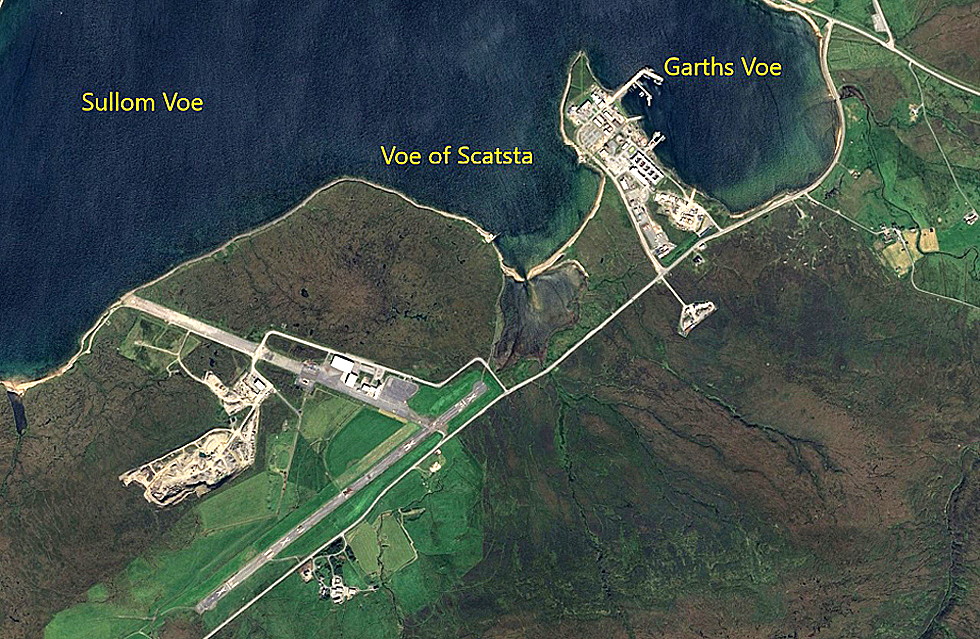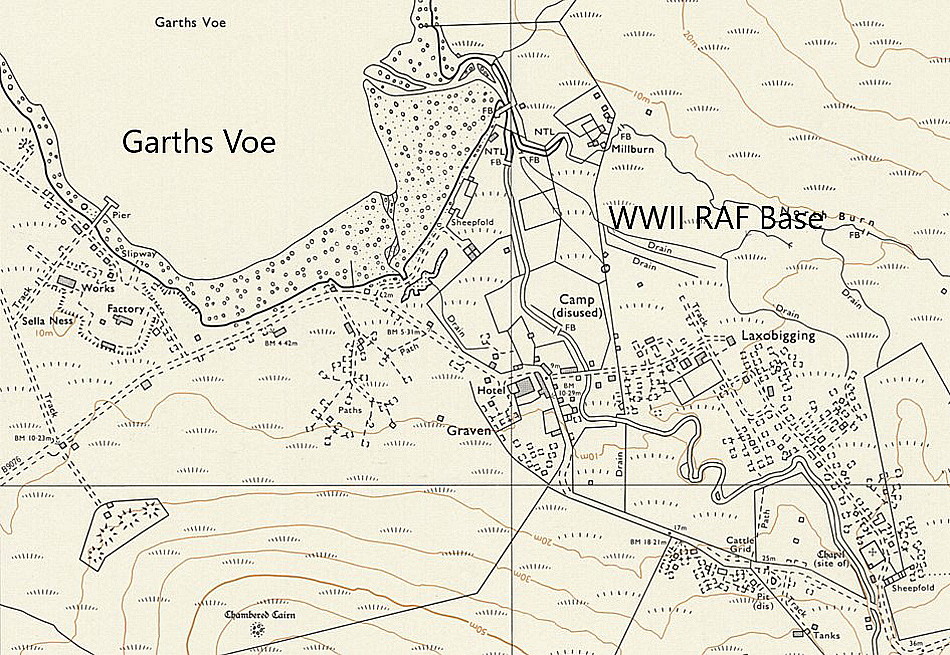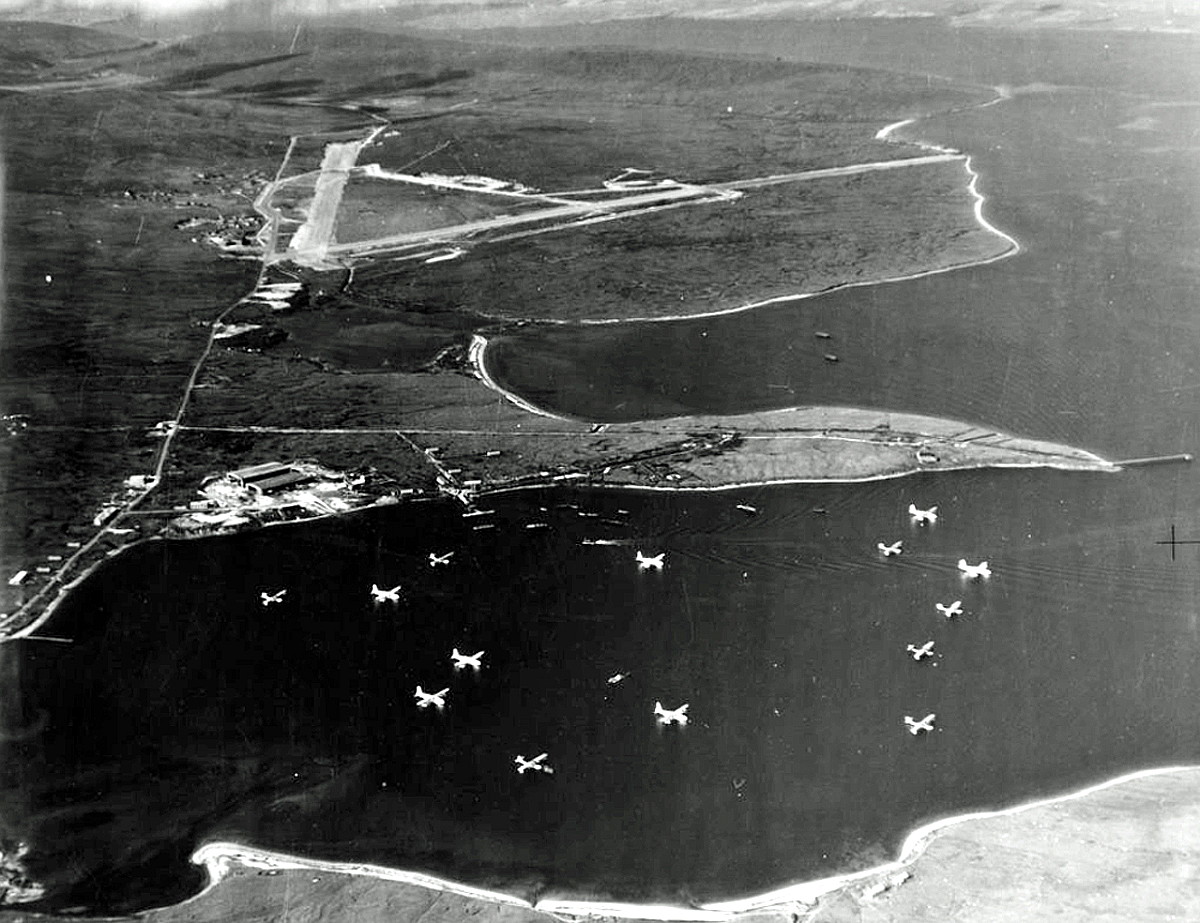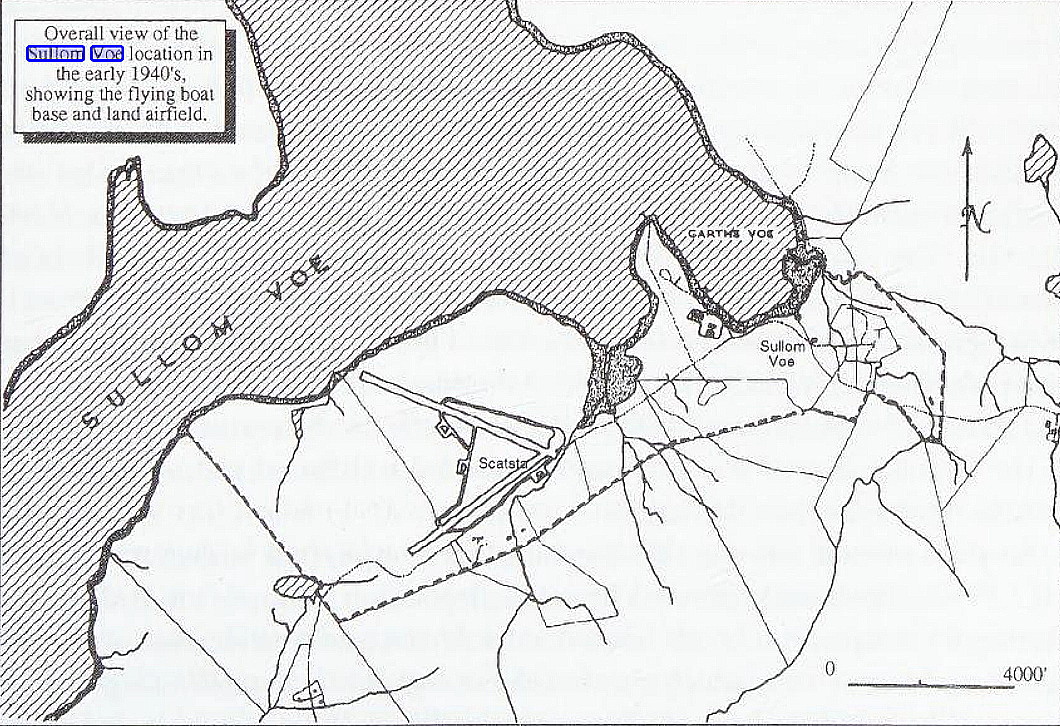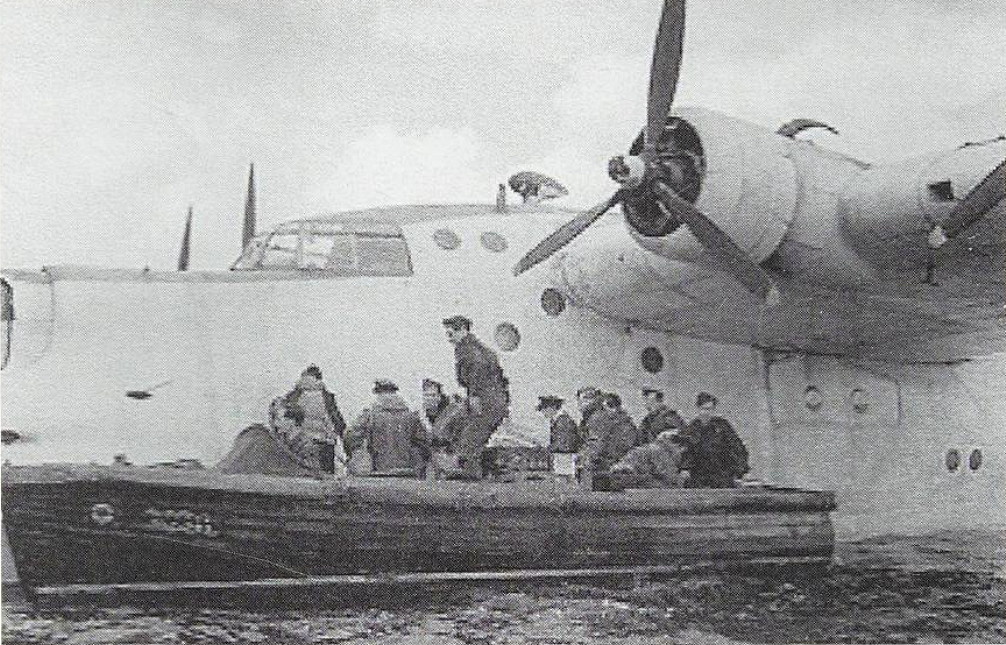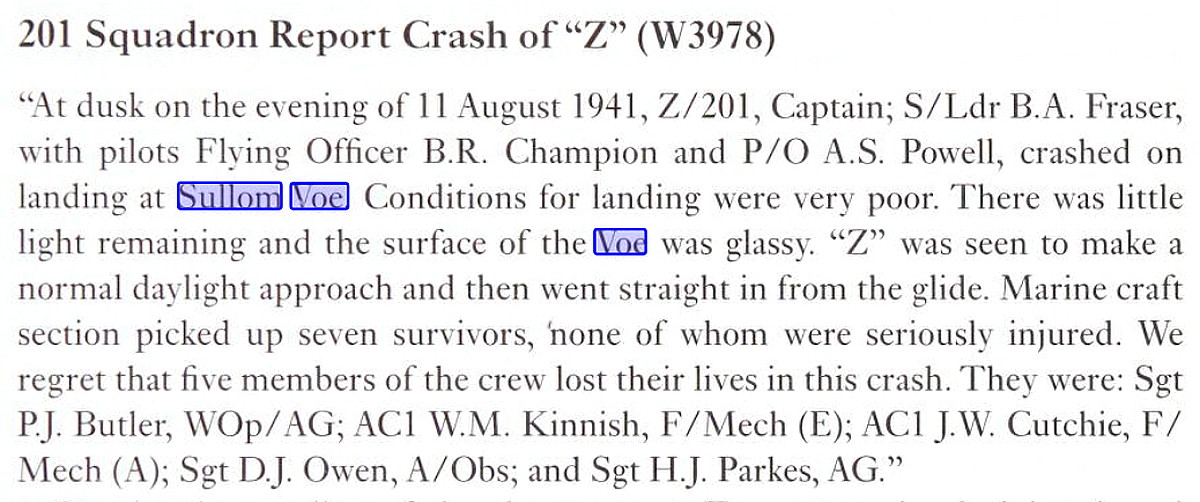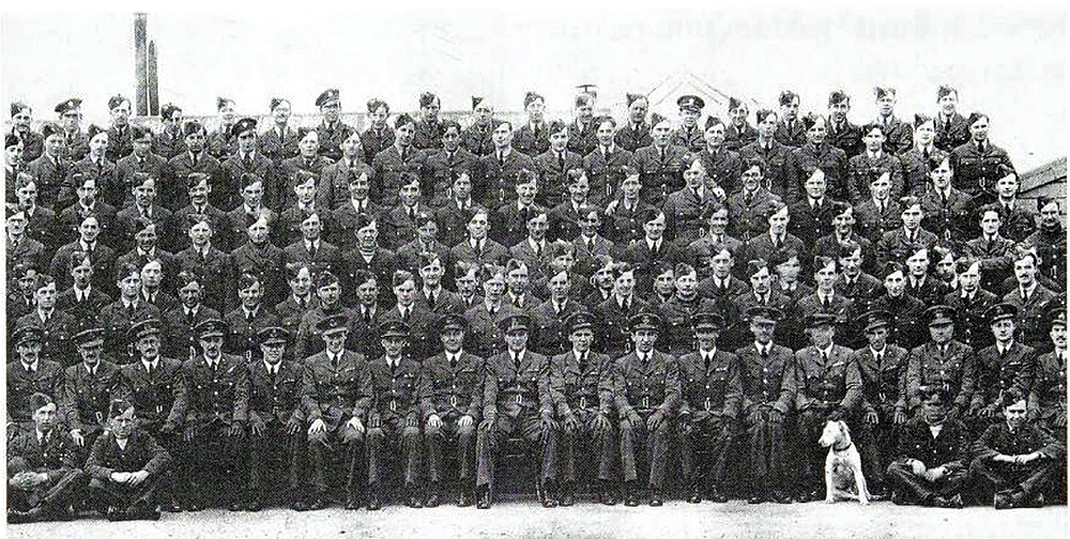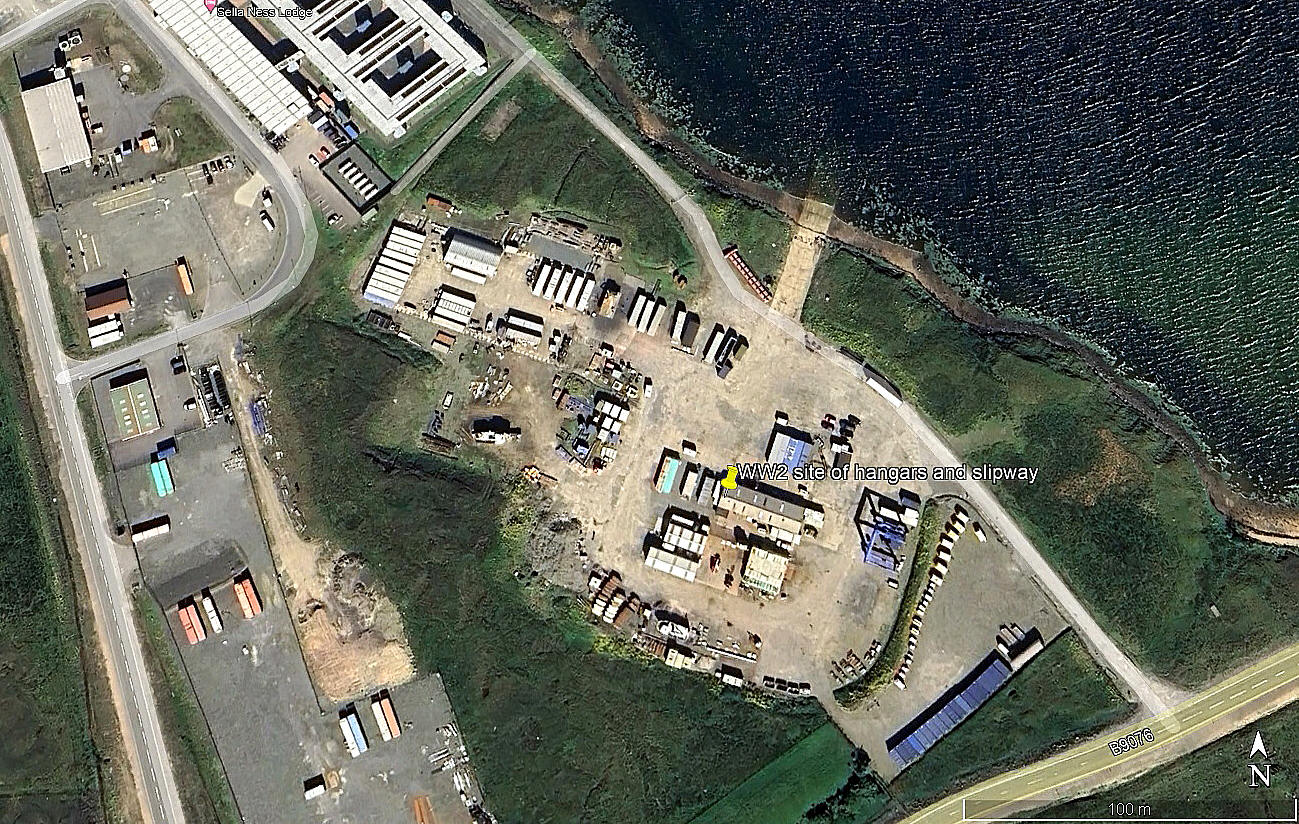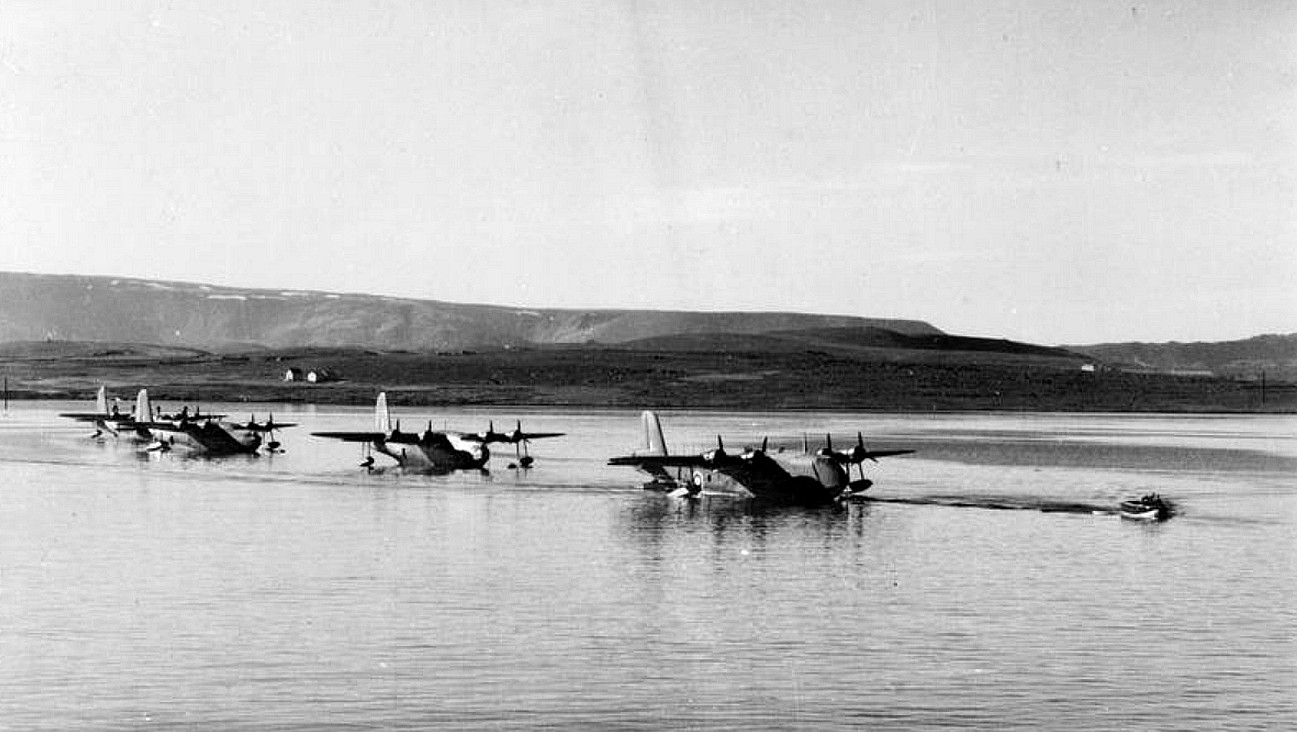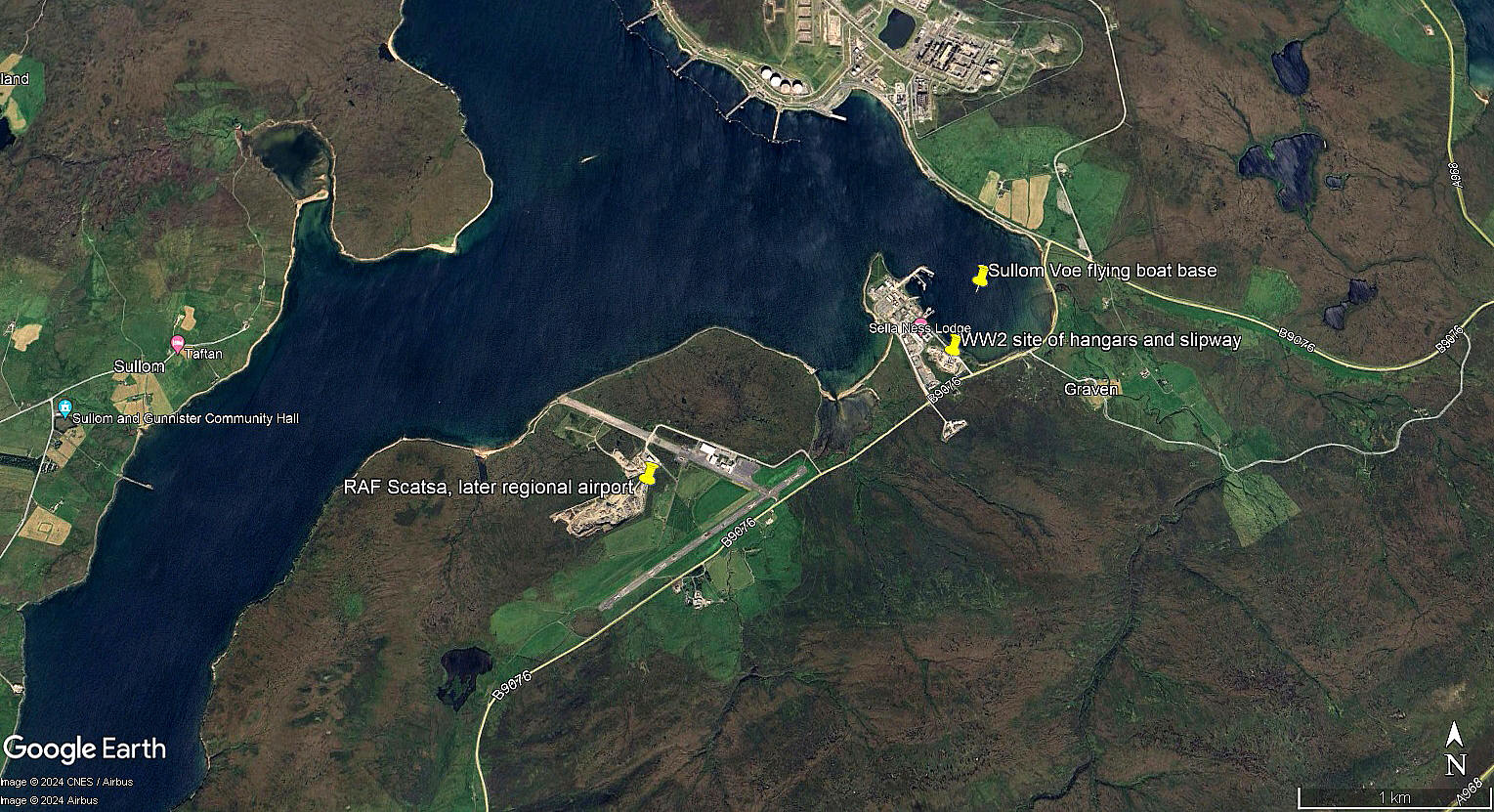Sullom Voe
SULLOM VOE: Flying Boat Station
Note: These pictures are from my Google Earth © derived database.
Military user: WW2: RAF Coastal Command 18 Group
201 Sqdn (Saro Londons, later Short Sunderlands)
190, 210 & 413 (RCAF) Sqdns (Consolidated Catalinas)
204 & 461 (RAAF) Sqdns (Short Sunderlands)
Location: S of the Sullom Voe Oil Terminal, NE of RAF SCATSA
Period of operation: WW2 only?
Alighting areas: North west to south east one square mile, north east to south west two square miles
A MICHAEL T HOLDER GALLERY (With additions by the editor)
We have Mike Holder, a great friend of this 'Guide', to thank for providing most of the information, maps and photos etc.
Note: The great aerial photo was obtained from the Shetland Amenity Trust
ITEMS FROM: Twenty-five years with Flight Lieutenant Thomas Buchanan Clark by Chris Clark. Published by Pen & Sword Aviation and available as a KIndle.
Note: I have added the aerial detail and local area view. For those stationed here in WW2 it must have been a god-foresaken posting.
SOME ADVICE PLEASE
The photo above, from the Imperial War Museum, certainly captured my interest. The first flying boat in this line is clearly not a Sunderland but obviously a Short C-Class Empire type. But which one? Just a few were impressed into RAF serivce rather than being transferred to BOAC. With the RAF they were used for communication duties, basically ferrying aircrews and others between various locations.
But, two were converted to be S.23M types, and I think this may well be one of them. The picture is not too sharp, but, I think that four vertical ariels on the aft fuselage can be made out? If I am correct (?) this might indicate it was one of two converted to conduct ASV radar trials as the Mk.111 Atlantic . These being V3137, (ex G-AFCU, and V3138. (ex G-AFCV). It appears these were operated by 119 Squadron.
NOTES: As with many of the WW2 seaplane/flying boat base moorings, these were spread around. Information gleaned so far indicates that there were twenty-two were in Garth’s Voe, three in Heinkel Gap, two in Voxter Voe, five in Bite of Haggrister and five in Scatsa Voe.
RAF COASTAL COMMAND STATIONS
In 2014 I found a listing in Wikipedia for RAF Coastal Command Stations at the start of World War 2, then November 1940 and finally February 1942, with the squadrons and aircraft types operated, which was very helpful to confirm I had most of my details correct.
Plus, it added a few more. It therefore seemed worthwhile to provide a précis which I have reworked to suit this ‘Guide’.
START OF WW2
| RAF STATION | COUNTY | SQUADRON | AIRCRAFT TYPE OPERATED |
| DYCE | ABERDEENSHIRE | 612 | Avro Anson |
| MONTROSE | ANGUS | 269 | Avro Anson |
| MOUNT BATTEN | DEVON | 204 | Short Sunderland |
| WARMWELL | DORSET | 217 | Avro Anson |
| LEUCHARS | FIFE | 224 & 233 | Lockheed Hudson |
| THORNEY ISLAND | HAMPSHIRE | 22 & 48 | Vickers Vildebeest (22 Sqdn) Avro Anson (48 Sqdn) |
| DETLING | KENT | 500 | Avro Anson |
| BIRCHAM NEWTON | NORFOLK | 42 & 206 | Vickers Vildebeest (42 Sqdn) Avro Anson (206 Sqdn) |
| ALDERGROVE | COUNTY ANTRIM | 502 | Avro Anson |
| PEMBROKE DOCK | PEMBROKESHIRE | 210 & 228 | Short Sunderland |
| INVERGORDON* | ROSS-SHIRE | 209 & 240 | Supermarine Stranraer (209 Sqdn) Saro London (240 Sqdn) |
| SULLOM VOE | SHETLAND ISLES | 201 | Saro London |
| THORNABY | YORKSHIRE | 220 & 608 | Avro Anson |
*RAF INVERGORDON became RAF ALNESS in February 1943.
There were also four specialised units:
| Torpedo Training Unit | GOSPORT | HAMPSHIRE |
| No.2 Anti-Aircraft Co-operation Unit | GOSPORT | HAMPSHIRE |
| School of General Reconnaissance | THORNEY ISLAND | HAMPSHIRE |
| Seaplane Training Squadron | CALSHOT | HAMPSHIRE |
With the exception of THORNEY ISLAND, who were equipped with Avro Ansons, the other three used a variety of aircraft.
LISTING FOR THE 1st NOVEMBER 1940
| RAF STATION | COUNTY | SQUADRON | AIRCRAFT TYPES OPERATED |
| DYCE | ABERDEENSHIRE | 248 | Bristol Blenheim |
| OBAN | ARGYLLSHIRE | 210 | Short Sunderland |
| WICK | CAITHNESS | 42 | Bristol Beaufort |
| HOOTON PARK | CHESHIRE | 48 | Avro Anson |
| St EVAL | CORNWALL | 217 236 |
Avro Anson & Bristol Beaufort Bristol Blenheim |
| LEUCHARS | FIFE | 224 & 233 | Lockheed Hudson |
| THORNEY ISLAND | HAMPSHIRE | 59 | Bristol Blenheim |
| DETLING | KENT | 53 500 |
Bristol Blenheim Avro Anson |
| NORTH COATES | LINCOLNSHIRE | 22 | Bristol Beaufort |
| BIRCHAM NEWTON | NORFOLK | 206 235 |
Lockheed Hudson Bristol Blenheim |
| ALDERGROVE | COUNTY ANTRIM | 502 | Blackburn Botha & Armstrong Whitworth Whitley |
| CAREW CHERITON | PEMBROKESHIRE | 321* | Avro Anson |
| PEMBROKE DOCK | PEMBROKESHIRE | 10** 209 |
Short Sunderland Saro Lerwick |
| SULLOM VOE | SHETLAND ISLES | 201 & 204 | Short Sunderland |
| STRANRAER | WIGTOWNSHIRE | 240 | Supermarine Stranraer |
| THORNABY | YORKSHIRE | 220 608 |
Lockheed Hudson Avro Anson & Blackburn Botha |
*321 was a Dutch Squadron **10 Squadron was Royal Australian Air Force
By this time the specialised Units had changed quite a lot:
Torpedo Training Unit (Bristol Beaufort) ABBOTSINCH RENFREWSHIRE
No.2 OTU (Anson/Blenheim) CATFOSS YORKSHIRE
No.3 OTU (Various) CHIVENOR DEVON
No.1 Coast Artillery Co-operation Unit DETLING KENT (Bristol Blenheim)
No.2 Anti-Aircraft Co-operation Unit GOSPORT HAMPSHIRE
No.1 (Coastal) OTU (Various) SILLOTH CUMBERLAND
No.3 School of General Reconnaissance SQUIRES GATE LANCASHIRE (Blackburn Botha)
No.4 OTU (various) STRANREAR WIGTOWNSHIRE
By late 1940 Coastal Command had a Squadron (No.98) operating Fairey Battles from RAF Kaldadanes in Iceland. If today we might think a posting to RAF Sullom Voe or RAF Wick a bleak prospect in those days, those posted to Iceland must have thought they’d really pulled the short straw. Incidentally, I wonder how many people today realise that British forces invaded and took control of Iceland in an operation starting on the 10th May 1940?
LISTING FOR 12th FEBRUARY 1942
| RAF STATION | COUNTY | SQUADRON | AIRCRAFT TYPES OPERATED |
| DYCE | ABERDEENSHIRE | 235 | Bristol Beaufighter |
| OBAN | ARGYLLSHIRE | 210 | Consolidated Catalina |
| WICK | CAITHNESS | 48 & 608 | Lockheed Hudson |
| St EVAL | CORNWALL | 22& 86 217 224 502 |
Bristol Beaufort Bristol Beaufort Lockheed Hudson Armstrong Whitworth Whitley |
| MOUNT BATTEN | DEVON | 10 | Short Sunderland |
| LEUCHARS | FIFE | 42 320 489 |
Bristol Beaufort Lockheed Hudson Bristol Blenheim |
| THORNEY ISLAND | HAMPSHIRE | 22 & 217 233 415 |
Bristol Beaufort Lockheed Hudson Handley Page Hampden & Bristol Beaufort |
| DETLING | KENT | 280 | Avro Anson |
| NORTH COATES | LINCOLNSHIRE | 59 & 407 | Lockheed Hudson |
| BIRCHAM NEWTON | NORFOLK | 249 500 502 |
Bristol Beaufighter Lockheed Hudson Armstrong Whitworth Whitley |
| ALDERGROVE | COUNTY ANTRIM | 143 206 |
Bristol Blenheim Lockheed Hudson |
| CASTLE ARCHDALE | COUNTY FERMANAGH | 201 | Short Sunderland |
| LIMAVADY | COUNTY LONDONDERRY | 53 | Lockheed Hudson |
| NUTTS CORNER | COUNTY ANTRIM | 120 220 |
Consolidated Liberator Boeing Fortress |
| CAREW CHERITON | PEMBROKESHIRE | 254 | Bristol Blenheim |
| PEMBROKE DOCK | PEMBROKESHIRE | 209 | Consolidated Catalina |
| SULLOM VOE | SHETLAND ISLES | 413 | Consolidated Catalina |
| SUMBURGH | SHETLAND ISLES | 404 | Bristol Blenheim |
| STRANREAR | WIGTOWNSHIRE | 228 | Short Sunderland |
In early 1942 RAF Coastal Command were also charged with operating No.1402 (Meteorological) Flight from RAF Aldergrove flying biplane Gloster Gladiators and Spitfires. Also from RAF Alderove, No.1405 (Meteorological) Flight flying Bristol Blenheims and Lockheed Hudsons. All in NORTHERN IRELAND of course.
No.1401 (Meteorological) Flight were flying Bristol Blenheims from RAF Bircham Newton (NORFOLK). It came as quite a surprise to me to learn that No.1 Photographic Reconnaissance Unit based at Benson (OXFORDSHIRE) were under Coastal Command in 16 Group. Up at Wick (CAITHNESS) in northern Scotland No.1406 Meteorological Flight were flying Bristol Blenheims whereas, at the same period, No.1408 ‘Met’ Flight, also based here, were flying Lockheed Hudsons. At St Eval (CORNWALL) No.1404 ‘Met’ Flight were also flying Lockheed Hudsons.
A bit further east in (DEVON) at RAF Chivenor No.1417 (Leigh Light Trials) Flight were flying Vickers Wellingtons, the bomber famous for having the ‘geodetic’ fuselage type of contruction adopted by Barnes Wallis. The ‘Leigh Light’ was a very powerful searchlight which could be used in conjunction with ASV radar to attack German U-boats at night.
No.1 Photographic Reconnaissance Unit, based at RAF Benson (OXFORDSHIRE) had their ‘B Flight’ at St Eval flying Bristol Blenheims.
I trust you will agree that including this ‘table’ or ‘listing’ has been worthwhile, and, hopefully interesting. The credit due to the crews of RAF Coastal Command, the ‘Cinderalla Service’ is long overdue. It will probably never be determined as to just how effective most of Coastal Command duties actually were, but today there is no doubt they played a crucial role, easily arguably on a level equivalent to the contribution made by RAF Fighter Command? But, it would be senseless to now try to award 'Brownie' points. Even at the time they had none of the ‘glory’ accorded, it was mostly a thankless task, little appreciated if at all by the British public. But, I would like to think judging by accounts of those that flew these missions, the majority of the crews were in no doubt at all regarding the immense value they were adding to the war effort. And, they were right, no doubt about it.
ADAPTING
I also think it is of interest to see, over a period of three short years, how RAF Coastal Command had, for example, quite quickly adapted from their beloved huge biplane flying boats such as the Supermarine Stranrear and Saro London, via the Short Sunderland to the Consolidated Catalina. It must be remembered that the Catalina was not a replacement for the Sunderland – far from it. In fact it can easily be argued that the Sunderland was, especially if attacked by enemy aircraft, the most formidable foe of any flying boat ever built.
The Germans as I recall, called it ‘The Flying Porcupine’. When attacked, if you could get a Sunderland down to ‘deck’ level and weaving, it was a very formidable opponent. The classic story is the event of a Sunderland of 461 RAAF Squadron, flown by Colin Walker (with only two British crewmen on board) being attacked over the Bay of Biscay by eight Junkers JU.88C heavy fighters. The Sunderland crew shot down two, damaged others, and it is alleged, only two of the Junkers made it back to their base. Although heavily damaged and with one fatality, they limped back to crash land at Praa Sands in Cornwall, in Mount’s Bay.
We'd love to hear from you, so please scroll down to leave a comment!
Leave a comment ...
Copyright (c) UK Airfield Guide















